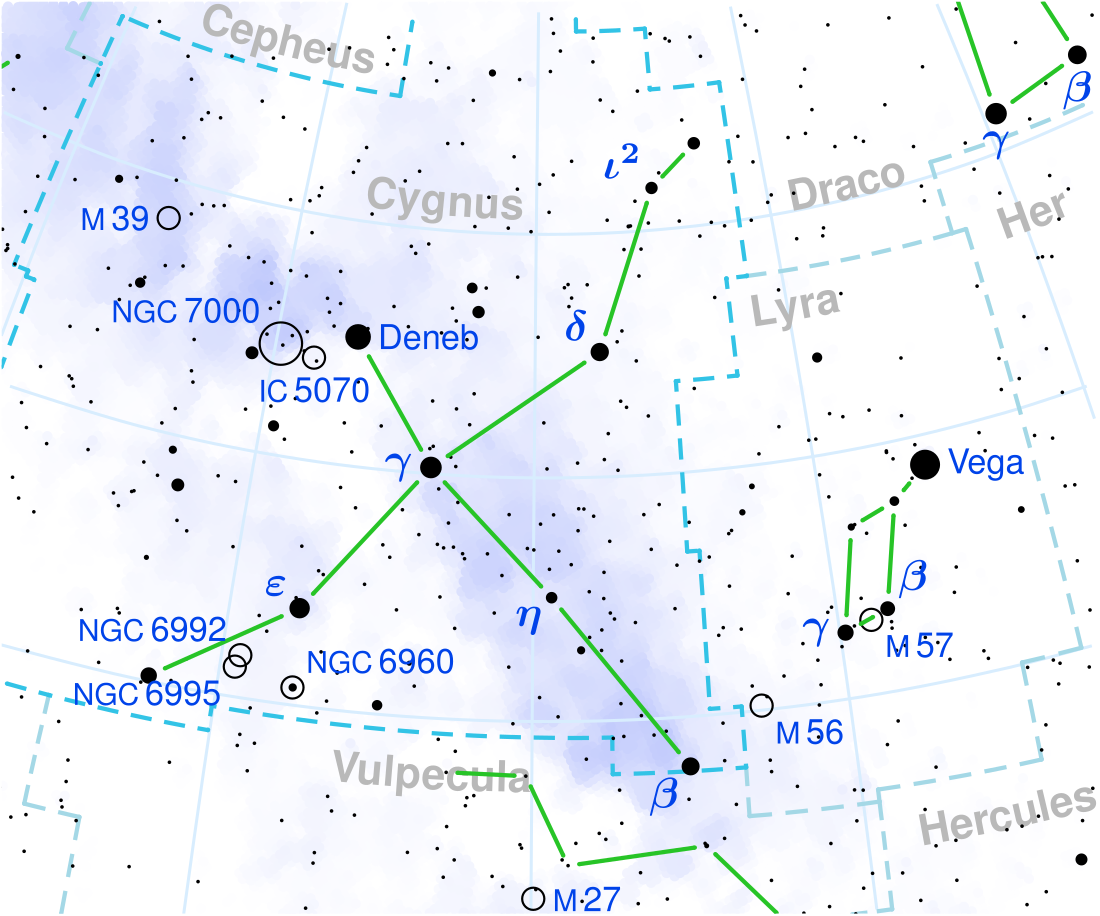Top Qs
Timeline
Chat
Perspective
Epsilon Cygni
Star in the constellation Cygnus From Wikipedia, the free encyclopedia
Remove ads
Epsilon Cygni (ε Cygni, abbreviated Epsilon Cyg, ε Cyg) is binary star in the constellation of Cygnus. With an apparent visual magnitude of 2.48, it is readily visible to the naked eye at night, and is the third-brightest star in the constellation. Based upon parallax measurement, Epsilon Cygni is about 73 light-years distant.
Remove ads
The system has two confirmed constituents, Epsilon Cygni Aa (officially named Aljanah /ˈældʒənə/) and Ab. Additionally, a visual companion (Epsilon Cygni C) is likely bound to the system.[3]
Remove ads
Nomenclature
Summarize
Perspective
ε Cygni (Latinised to Epsilon Cygni) is the system's Bayer designation. The designations of the three constituents as Epsilon Cygni A, B and C, and those of A's components - Epsilon Cygni Aa and Ab - derive from the convention used by the Washington Multiplicity Catalog (WMC) for multiple star systems, and adopted by the International Astronomical Union (IAU).[10]
Epsilon Cygni bore the traditional name Gienah from the Arabic al janāħ (Arabic: جناح) meaning "the wing".[11] However that name was more usually applied to Gamma Corvi.[8] For reasons of disambiguation it was sometimes called Gienah Cygni. In 2016, the IAU organized a Working Group on Star Names (WGSN)[12] to catalog and standardize proper names for stars. The WGSN decided to attribute proper names to individual stars rather than entire multiple systems.[13] It approved the name Aljanah for the component Epsilon Cygni Aa on 30 June 2017. It had previously approved the name Gienah for Gamma Corvi A on 6 November 2016. Both are now so included in the List of IAU-approved Star Names.[14]
In Chinese astronomy, the "Celestial Ford" (Chinese: 天津; pinyin: Tiān Jīn) refers to an asterism consisting of Epsilon Cygni, Gamma Cygni, Delta Cygni, 30 Cygni, Alpha Cygni, Nu Cygni, Tau Cygni, Upsilon Cygni and Zeta Cygni.[15] Consequently, the Chinese name for Epsilon Cygni Cygni itself is "the Ninth Star of Celestial Ford" (Chinese: 天津九; pinyin: Tiān Jīn jiǔ).[16]
Remove ads
Companions
Epsilon Cygni A has an optical companion, Epsilon Cygni B, with which it is not physically associated, and a 13th magnitude candidate common proper motion companion, Epsilon Cygni C, at an angular separation of 78 arcseconds.[17] If the latter star is gravitationally bound to Epsilon Cygni A, then they are currently separated by 1,700 AU or more, and have an orbital period of at least 50,000 years.[18]
Remove ads
Properties
Summarize
Perspective

Epsilon Cygni A is a single-lined spectroscopic binary.[19] The components take 53 years to complete an orbit and are in a highly eccentric orbit, which put their distances from 1.1 astronomical units in apoapsis to 30.5 astronomical units in periapsis.[3][a] Its main component is a giant star with a stellar classification of K0 III.[20] This indicates that the star has left the main sequence and has begun the final stages in its stellar evolution. After passing through the red-giant branch stage, it underwent a helium flash event and is now a horizontal branch star generating energy through the thermonuclear fusion of helium at its core.[3] The effective temperature of its photosphere is 4,700 K,[6] giving an orange hue that is a characteristic of K-type stars.[21] Being 10% more massive than the Sun and nine billion years old,[3] It has 11 times the radius of the Sun[6] and is about 56 times more luminous.[7]
The secondary has never been observed directly, its existence was inferred solely on astronomical spectroscopy. Based on this data, it should have a mass of at least 0.265 M☉.[3]
Since 1943, the spectrum of Epsilon Cygni A has served as one of the stable anchor points by which other stars are classified.[22]
Veil Nebula
ε Cygni lies about three degrees north of the Veil nebula, a probable ancient supernova remnant. The nebula is far more distant than the star.
Notes
References
External links
Wikiwand - on
Seamless Wikipedia browsing. On steroids.
Remove ads

